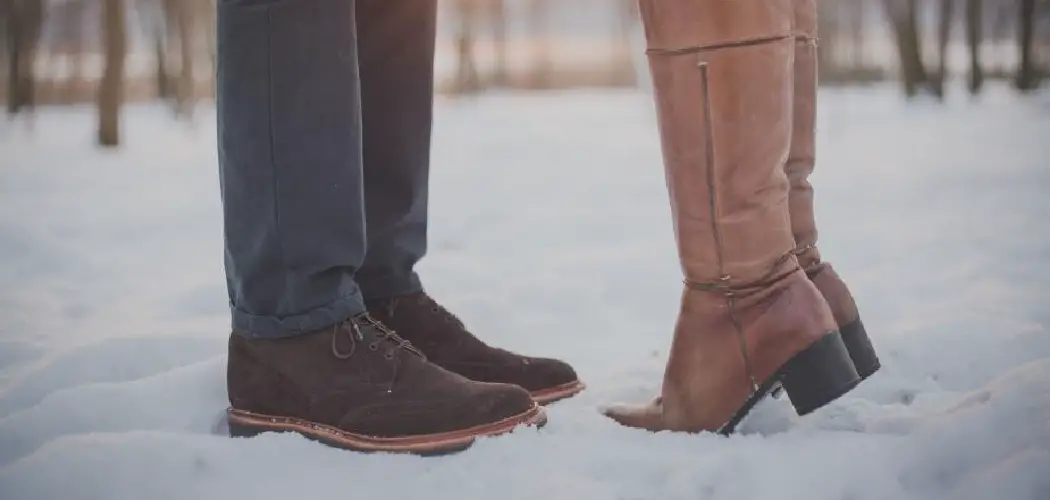Are you ready to step out in the snow this winter? If so, it’s essential to ensure you have the proper boots to keep your feet warm and dry. But with so many styles and brands on the market, how do you know which will fit your feet best?
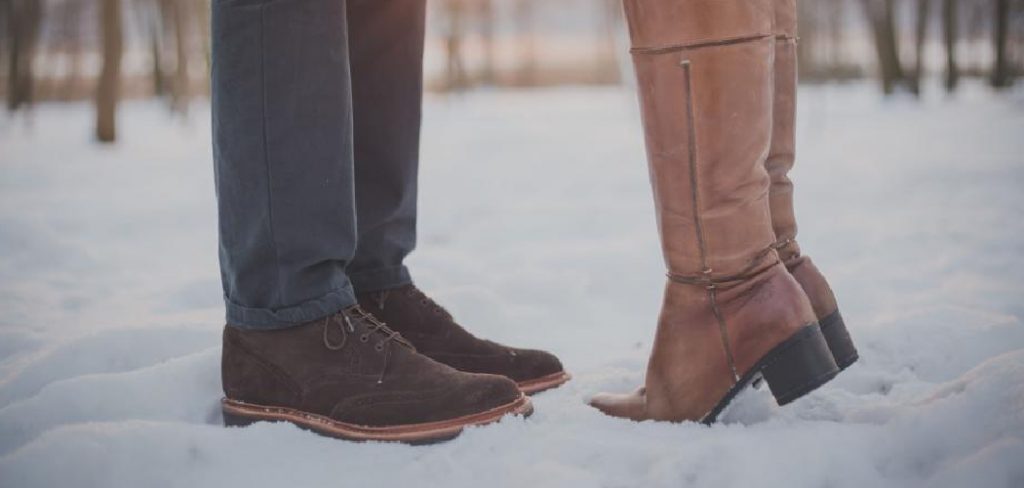
The perfect fit for winter boots is essential for comfort and functionality during the cold months. As winter brings snow, rain, and ice, having boots that fit well ensures warmth and protection from the elements and prevents discomfort and injuries.
It’s important to strike a balance where the boots are snug enough to protect against the cold but also roomy enough to allow for natural foot movement. Understanding how should winter boots fit can make a remarkable difference in your winter footwear experience.
What Will You Need?
Before we discuss the specifics of how winter boots should fit, let’s first consider what you will need to ensure an accurate fit.
- Socks: Be sure to wear the type of socks that you would typically wear in cold weather. This way, you can get an accurate feel for the fit with your preferred sock thickness.
- Insoles: If you use any specialized insoles or orthotics, bring them along as well. They may affect the fit and comfort of your boots.
Once you have these items ready, it’s time to find your perfect winter boot fit.
10 Easy Steps on How Should Winter Boots Fit
Step 1. Measure Your Foot Length and Width:
To ensure your winter boots fit perfectly, accurately measure your foot length and width. This is crucial because having the correct measurements guarantees a better fit. Use a ruler or a foot measuring device, preferably at the end of the day when feet tend to be at their largest.
Place your foot on a piece of paper, and with a pencil, trace the outline of your foot. Make sure the pencil is held upright for precision. Measure the length from the tip of your longest toe to the back of your heel. Record this measurement. For the width, measure the broadest part of your foot.
Once you have these measurements, cross-reference them with the sizing chart of the winter boots you are considering. Remember, different brands may have unique sizing systems, so always check the specific size guide provided. This step is fundamental in identifying the correct size, helping to ensure your winter boots will be comfortable and functional in colder weather conditions.
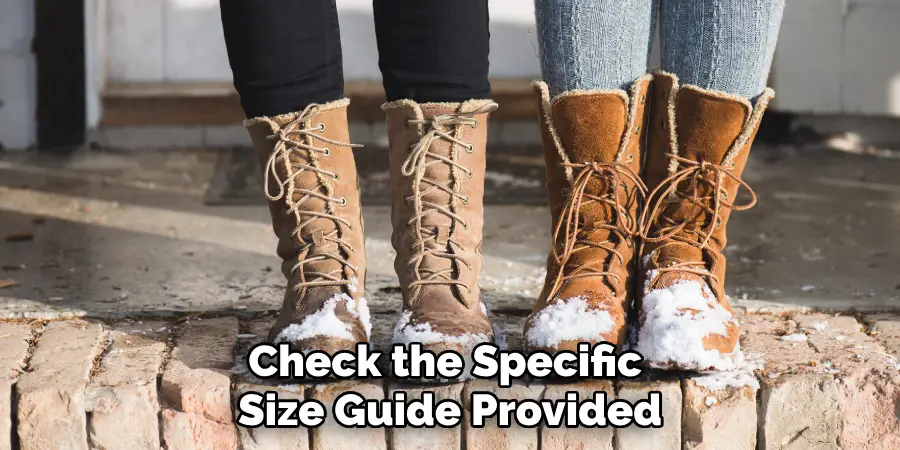
Step 2. Consider the Boot’s Lining and Insulation:
Understanding the lining and insulation of winter boots is essential for choosing the right fit. Many winter boots come with various linings such as fleece, wool, or synthetic materials, each providing different levels of warmth.
Try on the shoes with your chosen socks and insoles to test how the linings feel against your skin. Ensure the insulation does not make the shoes too tight; there should be enough room for your toes to move comfortably. Proper insulation will keep your feet warm without restricting circulation, providing comfort and protection during winter activities.
Step 3. Check the Boot’s Flexibility:
Flexibility is crucial when selecting winter boots as it affects how comfortably your foot can move. To test flexibility, try bending the boot at the foot ball when you have it on. It should offer some resistance but not feel overly stiff, allowing natural foot movement while walking.
The upper part of the boot should also have a balance of support and softness. This flexibility is essential to prevent strain and ease movement during activities like walking or shoveling snow.
Step 4. Test the Arch Support and Insole Cushioning:
Proper arch support and insole cushioning are pivotal to foot comfort, especially in winter boots, which are often worn for extended periods. When testing the boots, press down on the insole with your fingers to evaluate the cushioning level—ideally, it should provide a soft yet supportive feel.
Next, pay attention to the arch area: slide your foot inside the boot and note how well the arch of your foot aligns with the built-in shoe support. Good arch support will distribute your weight evenly across your foot, minimizing discomfort and preventing fatigue during prolonged wear.
If needed, consider custom or specialized insoles to improve fit and comfort. Ensuring these elements are optimal will enhance your comfort, help maintain foot posture, and prevent foot pain.
Step 5. Evaluate Ankle Support:
Ankle support is vital when fitting winter boots, as it ensures stability on slippery surfaces. The shoes should fit snugly around your ankle without pinching or restricting movement. When trying on the shoes, provide adequate support by gently moving your ankle side to side and paying attention to how secure your foot feels.
If the ankle feels unsupported or too loose, it could lead to instability or discomfort during wear. Look for boots with reinforced ankle areas or adjustable features for a more tailored fit. Ensuring proper ankle support will contribute to safer and more comfortable winter activities.

Step 6. Assess the Toe Box Room:
The toe box should provide enough space for your toes to move freely while still being snug enough to keep your feet warm. Wiggle your toes inside the boots to ensure ample room without feeling constrained.
The right fit in the toe box will prevent blisters and cold spots, as cramped toes can lead to poor circulation and discomfort in cold weather. If your toes touch the end of the boot or feel squeezed, consider trying a size up or a different style to achieve a proper fit. A comfortable toe box is essential for maintaining warmth and comfort during prolonged wear in winter conditions.
Step 7. Check the Heel Fit:
The fit around the heel is critical to ensure that the boots provide comfort and support. When wearing the boots, ensure your heel sits snugly in place without sliding up and down as you walk. Test this by taking a few steps and checking if your heel remains secure. If there’s excessive movement or lifting at the heel, it could lead to blisters and discomfort during prolonged use.
A well-fitting heel is critical to optimal support and stability, preventing unnecessary friction and ensuring your winter boots perform effectively in various conditions. If necessary, seek boots with adjustable lacing or straps that allow you to fine-tune the fit around the heel area for added security.
Step 8. Test Out the Sole Traction:
Traction is crucial for winter boots to ensure safety and stability on icy or snowy surfaces. Examine the sole of the shoes to check for deep, multidirectional tread patterns, which enhance grip.
The material of the sole should be durable and slip-resistant, often made from rubber or similar composites. To evaluate the traction firsthand, try walking on different surfaces if possible, focusing on how well the boots maintain grip. Proper traction in the soles prevents slips and falls and provides confidence while navigating various winter terrains.
Consider boots with specialized features like ridges or studs for added traction if your winter activities require it. Prioritizing sole traction is essential for ensuring that your winter boots offer reliable performance in challenging weather conditions.
Step 9. Maintain Your Winter Boots Properly:
Proper maintenance of winter boots is important to extend their lifespan and ensure they continue to perform well. After each use, clean off any mud, salt, or debris to prevent material deterioration. Use a damp cloth or brush to gently remove dirt, and consider using a waterproofing spray or treatment to protect the boots against moisture.
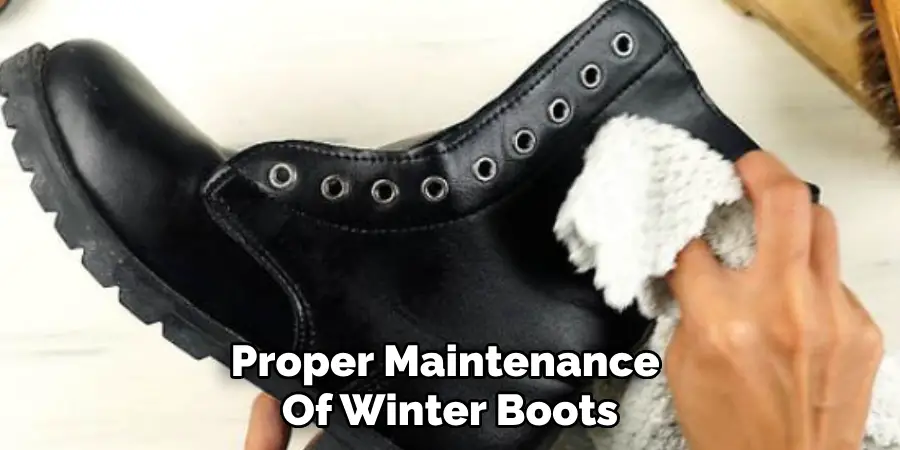
It’s also essential to dry your boots properly after exposure to wet conditions—avoid placing them directly next to heaters as it may cause cracking. Instead, let them air dry naturally. Regular maintenance preserves the boots’ appearance and functionality and guarantees that they offer the best protection and comfort throughout the winter season.
Step 10. Store Your Winter Boots Appropriately:
Proper storage of winter boots during the off-season is essential to maintain their shape and quality. Before storing your boots, ensure they are clean and dehydrated. Stuff the boots with newspaper or a shoe tree to help retain their shape and absorb residual moisture. Store them in a cool, dry place away from direct sunlight, which can cause fading and material degradation.
You might also consider placing them in a breathable shoe bag or box to protect them from dust. Periodically check your stored boots for any signs of mold or insects. Proper storage will help preserve the durability and condition of your winter boots, ensuring they are ready for use when the next winter season arrives.
Following these steps, you can confidently select a pair of winter boots that fit well and offer the necessary support, comfort, and durability for all your winter activities.
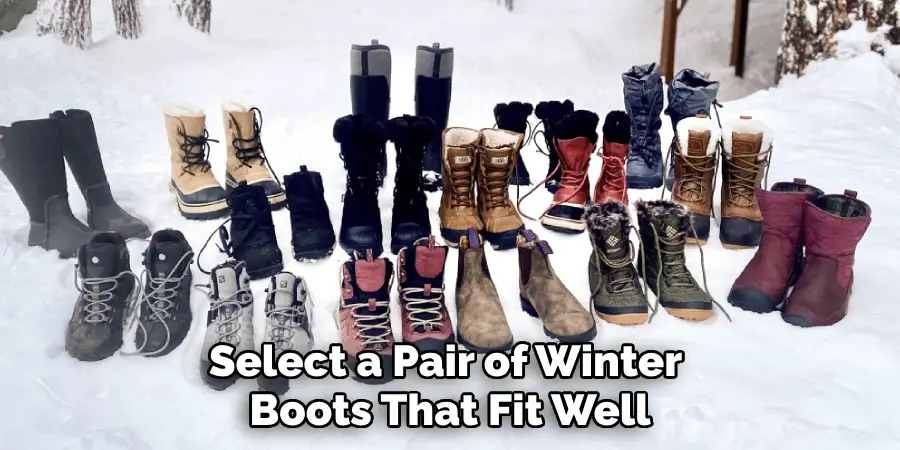
Conclusion
How should winter boots fit, combining several crucial elements that prioritize comfort and functionality?
A properly fitting pair of winter boots should provide ample insulation and support across all foot areas, prevent slipping or instability with adequate ankle and heel support, and accommodate natural movement with a well-sized toe box. Essential features like sole traction and maintenance enhance the boots’ durability and performance in harsh winter conditions.
By ensuring the correct fit and actively maintaining your boots, you’ll safeguard against the cold, enjoy superior comfort, and extend the product’s lifespan, making your winter adventures safe and enjoyable.

